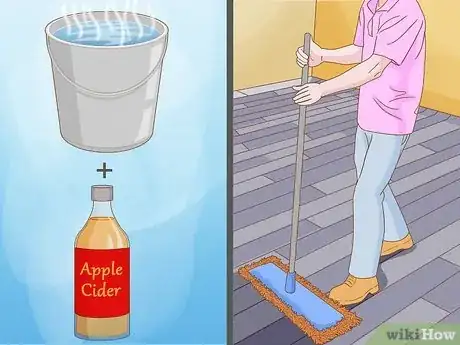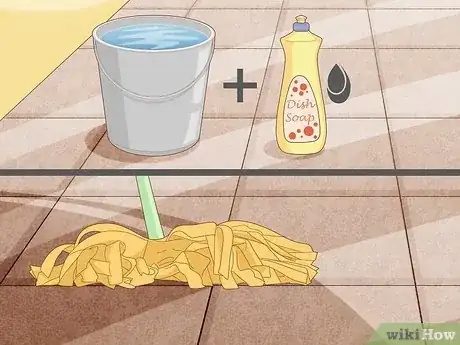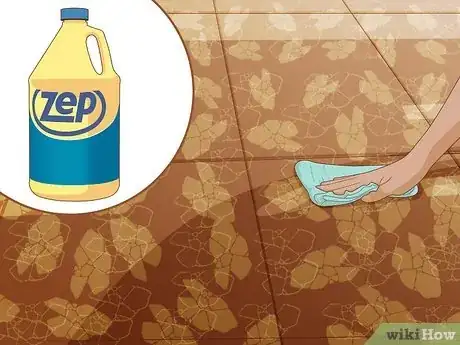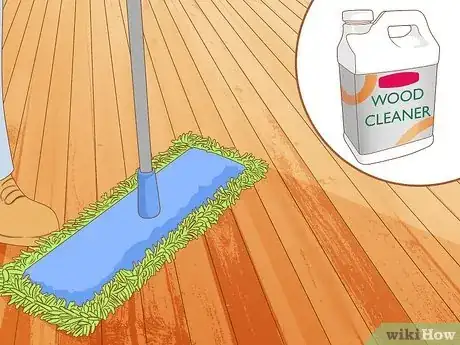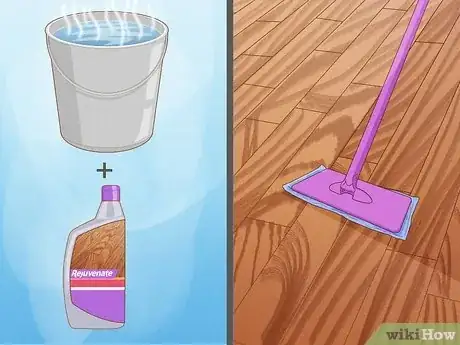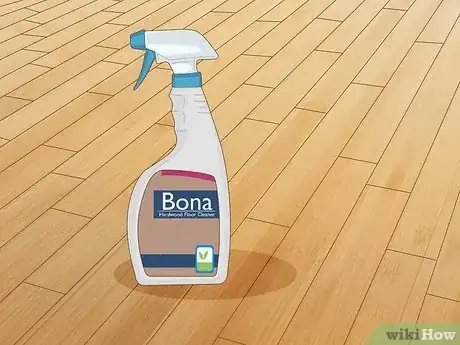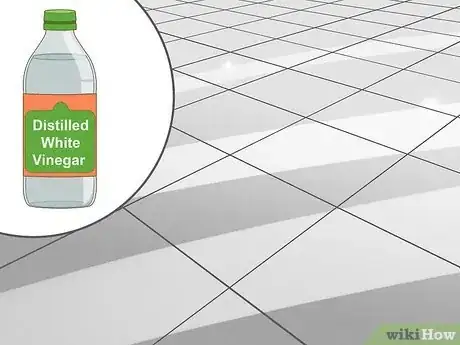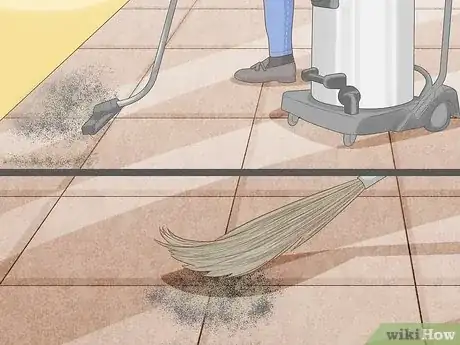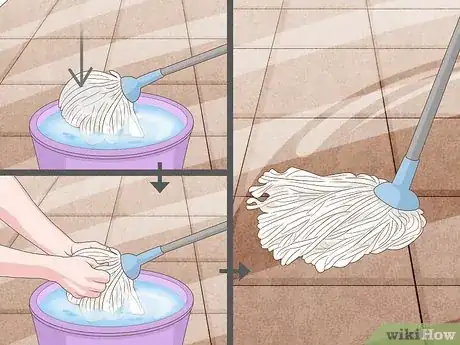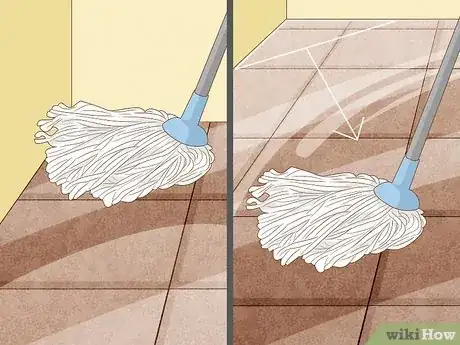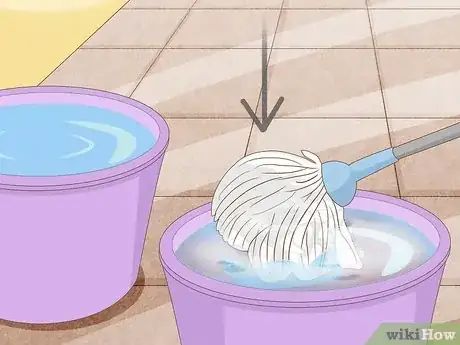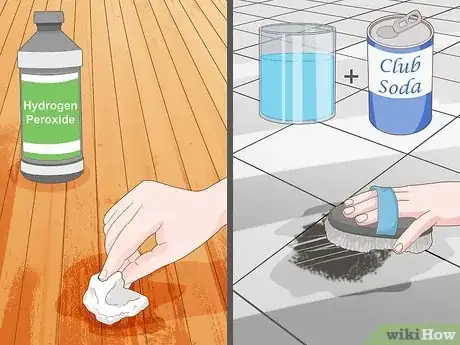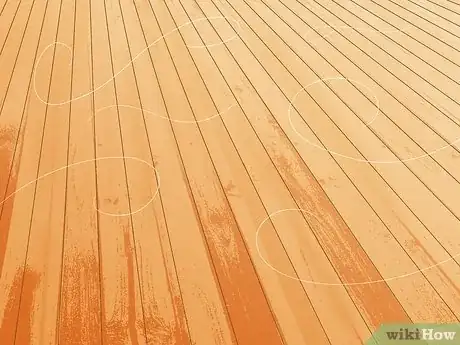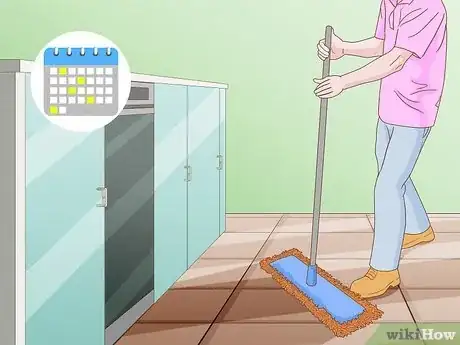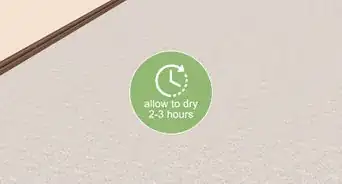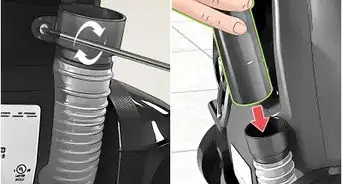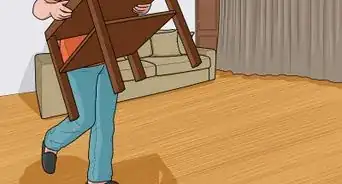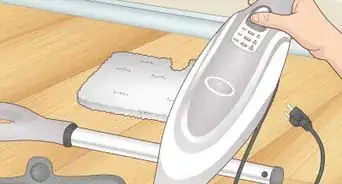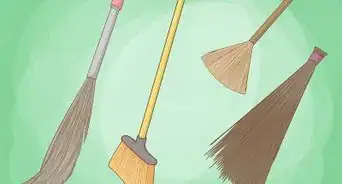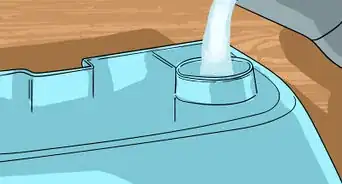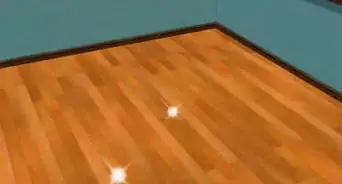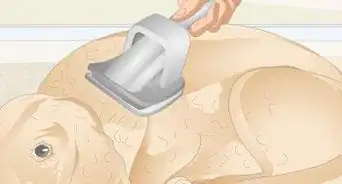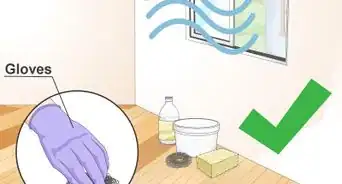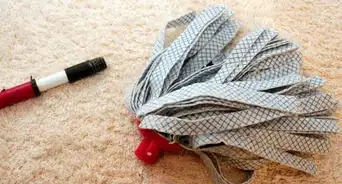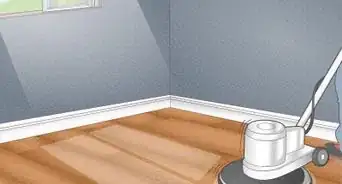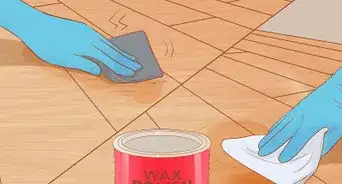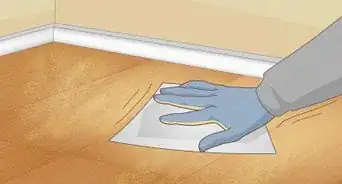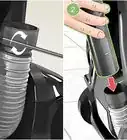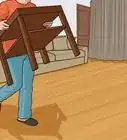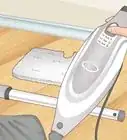This article was co-authored by Ashley Matuska and by wikiHow staff writer, Janice Tieperman. Ashley Matuska is a Professional Cleaner at the Founder and Owner of Dashing Maids in Denver, Colorado. Ashley has over seven years of experience in the cleaning industry. She and her team specialize in offering sustainable deep cleaning and maintenance cleaning services.
There are 21 references cited in this article, which can be found at the bottom of the page.
This article has been viewed 41,727 times.
Let’s face it—between cooking, meal prep, and general foot traffic, kitchen floors can start looking a bit worse for wear. But with all the different mops and cleaners out there, how are you supposed to know the best way to clean your floor? We’ve got you covered. Read on to learn the best cleaners for all types of floorings, as well as the best way to mop your kitchen floor. With a little TLC, your floors will be beautiful and sparkling in no time.
Things You Should Know
- Clean linoleum, marble, granite, and slate with a pH-neutral cleaner, and clean hardwood floors with a hardwood-safe cleaner.
- Vinegar is a good cleaner for laminate, tile, unwaxed linoleum, and vinyl.
- Use sudsy water to clean ceramic and porcelain tile, and a bamboo- or hardwood-safe cleaner for bamboo.
Steps
Best Cleaners and Mops by Floor Type
-
1Cleanse vinyl floors with apple cider vinegar. Stir 1 c (240 mL) of apple cider vinegar and 1 US gal (3.8 L) of hot water together in a bucket. For a disinfecting boost, switch out apple cider vinegar with white vinegar.[1]
- A microfiber mop works well for this type of flooring.
- Squeeze a couple of drops of liquid dish soap into your cleaning mixture to attack tough spots of dirt and grime.
- Vinegar is safe to use on other surfaces, like no-wax linoleum and ceramic tile.[2]
-
2Clean ceramic and porcelain tile floors with sudsy water. Stir a few drops of mild dish detergent into a bucket of clean water. Then, grab a chamois-style mop to get started.[3]
- Clean the tile grout with a baking soda paste if it’s looking a little dirty.
- Scrub your tile floor with fresh lemon juice or a non-abrasive all-purpose cleaner if your tiles look a bit foggy from the soap.
Advertisement -
3Scrub slate, marble, granite, or linoleum with a pH-neutral cleaner. Acidic (low pH) cleaners can damage marble, slate, and granite, so make sure your cleaner doesn’t have any lemon juice, vinegar, or other acidic ingredients.[4] Instead, use a trusted brand like ZEP or Rejuvenate All Floors Cleaner.[5] Rejuvenate’s cleaner can be sprayed directly on the floor, while Zep’s cleaner needs to be diluted in a bucket.
- You can also use a diluted mixture of water and mild dish detergent to clean slate.
- Always clean marble flooring with a soft rag or mop, rather than a hard-bristle brush.
- A traditional mop or steam mop works well for slate floors.[6]
- A microfiber mop is a great option for granite floors.[7]
-
4Use a wood cleaner and a microfiber mop to clean hardwood floors. Steer clear of products like Murphy Oil Soap and acrylic polish—these leave your floor looking clouded and dull, not gleaming and bright.[8]
- Look for products like Bona’s PowerPlus Deep Clean Hardwood Floor Cleaner and Method’s Squirt + Mop Hard Floor Cleaner.[9] Both of these are usually sprayed or squirted directly on the floor.
- Don’t use vinegar to clean your hardwood floors, especially if they have a wax finish. Some homeowners find that vinegar hurts the finish on their floors.[10]
-
5Clean laminate floors with warm water. Spritz the water over the surface of your laminate floor and go over it with a flat mop. You can also dip your mop directly into a basin of water—just be sure to wring it out really well.[11]
- You can also clean laminate with products like Rejuvenate All-Floors Cleaner, Black Diamond Stoneworks Wood & Laminate Floor Cleaner, and Better Life Naturally Dirt-Destroying Floor Cleaner.[12] All of these cleaners can be squirted or sprayed directly onto the floor.
-
6Use a bamboo-safe floor cleaner to clean your bamboo floors. Bona and Murphy Oil Soap are both great brands that make bamboo-friendly products. Use a soft-cloth mop rather than a steam cleaner, which could damage them.[13]
- Bona’s Hardwood Floor Cleaner Spray can be spritzed directly on your floors, while Murphy Oil Soap needs to be diluted in a bucket.
-
7Use distilled white vinegar to clean tile and non-wax linoleum. In a large bucket or basin, add 1⁄2 c (120 mL) of distilled white vinegar for every 1⁄2 US gal (1.9 L) of water (or 1 US gal (3.8 L) if you’re working with ceramic tile).[14] This all-natural cleaner is also safe to use on laminate and vinyl floors.[15] [16] Be careful not to use it on stone or hardwood floors, though—it could cause damage.[17]
- A microfiber mop works well with a diluted vinegar mixture.[18]
Best Cleaning Techniques
-
1Vacuum or sweep your floor to get rid of any dirt, crumbs, and/or debris. Go from corner to corner in your kitchen, sucking or sweeping up any crumbs or debris that you see.[19] Focus on spots where crumbs and grime seem to collect the most, like beneath the countertop or by the trash can.
- If necessary, check that your vacuum is set to the correct suction setting before you get started. Some vacuums have settings for different floorings and materials, like upholstery, curtains, carpet, and hard floors.[20]
EXPERT TIPAshley Matuska is a Professional Cleaner at the Founder and Owner of Dashing Maids in Denver, Colorado. Ashley has over seven years of experience in the cleaning industry. She and her team specialize in offering sustainable deep cleaning and maintenance cleaning services.Professional Cleaner
 Ashley Matuska
Ashley Matuska
Professional CleanerUse a broom if you don't have a vacuum. Ashley Matuska of Dashing Maids says: "Make sure to move everything off the floor, because you don't want to have to stop and set your mop down every time you have to move something. Then, sweep or vacuum the floor thoroughly. However, if you have a vacuum that works on hard surfaces, use that rather than a broom, because it will pick up and remove dirt, rather than just sweeping it into the air."
-
2Dip your mop into the diluted cleaner and wring it out. Take extra care to wring out your mop if you’re cleaning a laminate, linoleum, or hardwood floor—these surfaces are best cleaned with a slightly damp mop. If you’re using a string mop, be sure to wring it out multiple times before wiping down the floor.[21]
- Skip this step if you’re using a spray cleaner—in this case, just spritz your cleaner directly on the floor and go over it with your mop.
-
3Start mopping in a corner and work your way out. For textured flooring, like tile or linoleum, guide your mop in a circular, figure-8-like movement. If you have a hardwood floor, follow the grain of the wood with your mop instead.[22]
- Mop with your back facing the kitchen exit so you can easily back out of the room once you’re done cleaning.
-
4Rinse your mop in a separate bucket of water. As you mop different sections of the kitchen floor, dip your mop in the bucket of clean (non-sudsy) water to rinse it out. That way, all the dirt and grime you pick up won’t transfer into your cleaning solution.[23]
-
5Spot-treat stubborn greasy spills and stains by hand. Don’t stress over greasy spots and stains as you’re mopping the floor—instead, go over them later with a stain-busting product that won’t damage your floor.[24] Here are a few simple grease removal remedies you can try:
- Wood: Dip a cotton ball in hydrogen peroxide and place it on the grease stain. Then, soak a separate cotton ball in ammonia and set it on top of the peroxide-soaked cotton. Keep soaking and layering new cotton balls with peroxide and ammonia until the grease goes away.[25]
- Tile: Scrub the grease spot with a mixture of water and club soda or with a non-abrasive floor cleaner.[26]
- All-Purpose Grease Cleaner (for non-waxed floors): Stir 1⁄4 c (59 mL) of white vinegar, 1 US tbsp (15 mL) of dish soap, ¼ cup (52.2 g) of washing soda, and 2 US gal (7.6 L) of tap water together in a bucket. Then, mop over the grease spot with the mixture.[27]
-
6Let the floor air-dry completely. Most floors will air-dry on their own—you don’t have to wipe them down with a clean cloth or towel.
- Try to mop late at night, or whenever people are less likely to be in the kitchen. That way, the floor can dry without getting dirty in the process.[28]
- Some materials, like laminate, are more sensitive to moisture. Blot up any leftover moisture or water that you see with a paper towel or clean cloth.[29]
-
7Sweep and clean your kitchen floor once a week. Grab a broom and sweep your kitchen whenever you prepare a meal—this helps keep your kitchen free of dirt and crumbs. Then, set aside time each week to mop your kitchen floor.[30]
- Your cleaning schedule really depends on your household. If you have a really busy household, you might have to clean your floor throughout the week.
Community Q&A
-
QuestionCan I use bleach mixed with soap to clean my vinyl floor?
 wikiHow Staff EditorThis answer was written by one of our trained team of researchers who validated it for accuracy and comprehensiveness.
wikiHow Staff EditorThis answer was written by one of our trained team of researchers who validated it for accuracy and comprehensiveness.
Staff Answer wikiHow Staff EditorStaff AnswerThat's not a great idea. Bleach is really strong and can eat away your shiny vinyl finish, which you definitely don't want. Try apple cider vinegar instead—it'll get your floor nice and clean without potentially damaging it.
wikiHow Staff EditorStaff AnswerThat's not a great idea. Bleach is really strong and can eat away your shiny vinyl finish, which you definitely don't want. Try apple cider vinegar instead—it'll get your floor nice and clean without potentially damaging it. -
QuestionMy stone floor is engrained with dirt. How can I get its blue coloring back?
 wikiHow Staff EditorThis answer was written by one of our trained team of researchers who validated it for accuracy and comprehensiveness.
wikiHow Staff EditorThis answer was written by one of our trained team of researchers who validated it for accuracy and comprehensiveness.
Staff Answer wikiHow Staff EditorStaff AnswerUse a pH-neutral cleaner to get the dirt and grime out of your stone floor. Steam mops are great for slate floors, while a microfiber mop is best for granite floors. If you have a marble floor, be sure to use a soft mop or cloth.
wikiHow Staff EditorStaff AnswerUse a pH-neutral cleaner to get the dirt and grime out of your stone floor. Steam mops are great for slate floors, while a microfiber mop is best for granite floors. If you have a marble floor, be sure to use a soft mop or cloth.
References
- ↑ https://www.bobvila.com/articles/how-to-clean-vinyl-flooring/
- ↑ https://greatist.com/health/cleaning-with-vinegar#floors
- ↑ https://www.bhg.com/homekeeping/house-cleaning/tips/how-to-clean-tile-floors/
- ↑ https://www.bhg.com/homekeeping/house-cleaning/tips/how-to-clean-tile-floors/
- ↑ https://www.bobvila.com/articles/best-floor-cleaner/
- ↑ https://www.cleanipedia.com/au/floor-and-surface-cleaning/clever-tips-for-cleaning-slate-floors.html
- ↑ https://www.bobvila.com/articles/homemade-granite-cleaner/
- ↑ https://www.thisoldhouse.com/flooring/21015626/how-to-clean-wood-floors
- ↑ https://www.thisoldhouse.com/flooring/21015626/how-to-clean-wood-floors
- ↑ https://www.bobvila.com/slideshow/15-things-you-should-never-ever-clean-with-vinegar-73031
- ↑ https://www.bobvila.com/articles/how-to-clean-laminate-floors/
- ↑ https://www.thisoldhouse.com/flooring/23042750/best-laminate-floor-cleaner
- ↑ https://www.bobvila.com/articles/how-to-clean-bamboo-flooring/
- ↑ https://greatist.com/health/cleaning-with-vinegar#floors
- ↑ https://www.bhg.com/homekeeping/house-cleaning/surface/how-to-clean-laminate-floors/
- ↑ https://www.bobvila.com/articles/how-to-clean-vinyl-flooring/
- ↑ https://greatist.com/health/cleaning-with-vinegar#floors
- ↑ https://www.apartmenttherapy.com/cleaning-floors-with-vinegar-265641
- ↑ https://www.bobvila.com/articles/how-to-mop-a-floor/
- ↑ https://www.mieleusa.com/pmedia/ZGA/TX2070/10847180-000-00_10847180-00.pdf
- ↑ https://www.bobvila.com/articles/how-to-mop-a-floor/
- ↑ https://www.bobvila.com/articles/how-to-mop-a-floor/
- ↑ https://www.bobvila.com/articles/how-to-mop-a-floor/
- ↑ https://www.cleanipedia.com/ph/floor-and-surface-cleaning/floor-cleaning-strategies-how-to-mop-kitchen-floors.html
- ↑ https://www.bhg.com/homekeeping/house-cleaning/surface/how-to-remove-stains-from-wood-floors/
- ↑ https://www.bhg.com/homekeeping/house-cleaning/surface/tile-stain-removal-guide/
- ↑ https://www.food.com/recipe/floor-grease-cutter-cleaner-393210
- ↑ https://thecleaninginstitute.org/kitchen-floor-cleaning-schedule/
- ↑ https://www.bobvila.com/articles/how-to-clean-laminate-floors/
- ↑ https://www.bhg.com/homekeeping/house-cleaning/house-cleaning-checklists/kitchen-cleaning-checklist/
- ↑ https://www.bobvila.com/articles/how-to-mop-a-floor/
